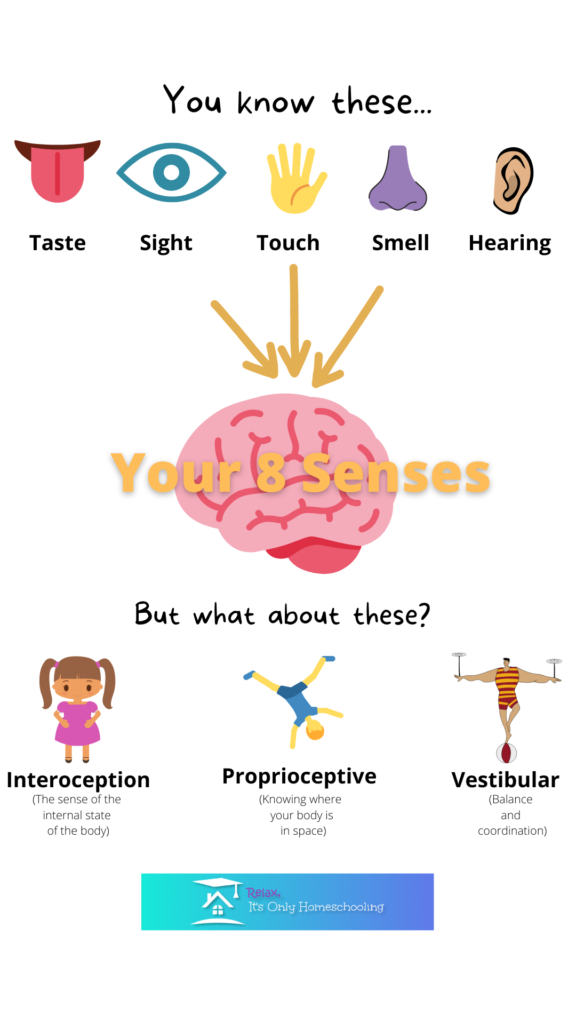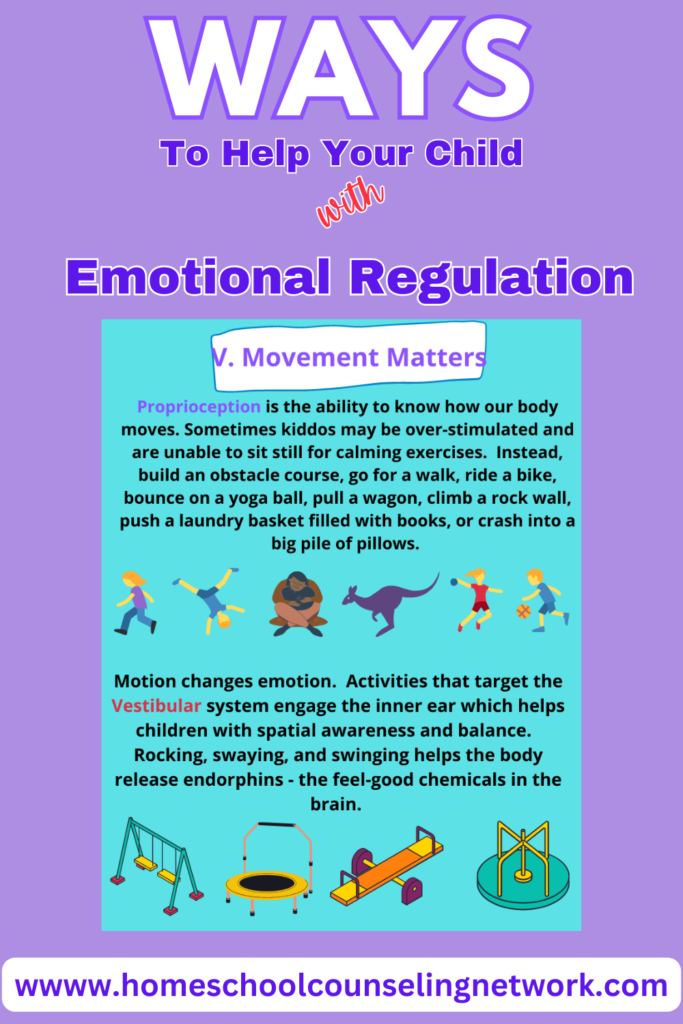Get Moving To Help Your Kids Manage BIG Feelings

In our last post, we introduced you to the mindfulness practice of cloud-watching.
Today, we are going to talk about the healing power of movement.
Movement Matters
Physical activity can be both fun and therapeutic.
You probably know that regular movement helps with coordination and balance. Did you also know that it helps build new neural network pathways in the brain? This concept is known as neuroplasticity. Daniel Lane, BSc DC (UK) from The Perth Brain Centre explains further:
Neuroplasticity means we can retrain our brains and essentially teach ourselves (and our children) new ways to respond to our thoughts and feelings. We touched on this topic a bit in earlier posts. Remember learning about grounding, The Power of the Pause, and the mindfulness exercise of cloud-watching?
Your Sensory System
We receive input from our eight senses about the world around us and inside us. Yes, eight. The first five you are likely already familiar with – taste, sight, touch, smell, and hearing. The other three senses are interoception, proprioceptive, and vestibular.

Interoception helps us understand and feel what is going on inside our bodies, such as recognizing when we are hungry, thirsty, or need to use the restroom.
Proprioception is our “body awareness” sense. The proprioceptive system tells us where our body parts are in space without us having to look for them.
The vestibular system is responsible for movement, balance, and coordination.
Sensory Motor Integration
Sensory Motor Integration (or sensory processing as it is sometimes called) refers to the way a person’s nervous system receives messages from the senses to the brain, processes said information and then executes an appropriate motor response.
Sensory integration is required for EVERYTHING we do! Learning how to brush your teeth, drive a car, drink through a straw, walk, hold a pencil, sit upright in a chair, master math facts, grasp grammar, or read a book ALL require sensory integration.
Do you know what else requires proper sensory-motor integration? That’s right, emotional regulation.
Know Thyself
Sensory integration is a neurological process in the central nervous system that involves receiving sensory information and turning it into functional responses. Successful sensory integration allows a person to feel safe in their environment and maintain an optimal level of arousal and attention by effectively processing and organizing sensory information from the environment. This process is integral to cognitive, emotional, and social functioning, impacting an individual’s overall well-being.
The Power of Sensory Integration: Enhancing Communication for Non-Speaking Individuals – Autism Spectrum News
So for all of us parents who did not earn a degree in occupational therapy, what exactly does this mean?
It means we are all a little different when it comes to how we interpret the information we receive from both the outside world and from inside our bodies. If we feel hot, we may remove our jackets. If we’re hungry, we may grab a snack. If we’re tired, we rest. And we do all of these things without a second thought.
Neurodiverse individuals (i.e., ADHD, Autism) or individuals with sensory processing difficulties may experience challenges in processing these external and internal feedback sensory signals. In turn, they may struggle with first how to identify their needs and second, how to effectively communicate their needs to others.
Learning Your Child’s Sensory Language
Kids don’t all have the same reactions to situations and stimuli. But their responses tend to fall into one of two categories.
Some kids tend to be “sensory seekers.” They underreact to sensory input or need more of it to function. Others are generally “sensory avoiders.” They overreact to sensory input and become overwhelmed and hyperactive.
Sensory seeking and sensory avoiding: What you need to know (understood.org)
Sometimes children may be overstimulated by the sensory input in their environment (i.e., bright lights, a loud plane flying overhead, strong smells of last night’s dinner dishes sitting in the sink – oh wait, those are just examples from my homeschool) or within their body (i.e., asking for a snack when hungry, recognizing when we one needs to use to restroom).
When feeling overwhelmed and ill-equipped to process all the stimuli coming at him, my son may fidget at his desk, ask for relaxation time, or even become tearful during a lesson.
Other times my child needs more sensory input to wake up his system so he can actively participate in the learning process. During these times, my son may ask for deep-pressure bear hugs, request to jump on his mini-trampoline, swing on our backyard swingset, or ask to build an obstacle course where he can crash into couch cushions.
These requests are how he communicates his sensory needs to me and how I, in turn, help him get his sensory needs met.
I have learned that helping my son find ways to either feed or calm down his sensory system (sensory seeking versus sensory avoiding), depending on what he is experiencing at the moment, has not only improved the quality of our homeschool but also enhanced our parent-child relationship overall.
Whether your child is a sensory seeker, a sensory avoider, or a bit of both, all behavior has a purpose. Learning that purpose and adjusting accordingly takes willingness, patience, and time.
Motion Changes Emotion
As we learned earlier, proprioception is the ability to know how our body moves in space. Proprioceptive activities include building an obstacle course, going for a walk, riding a bike, bouncing on a yoga ball, pulling a wagon, climbing a rock wall, pushing/pulling a laundry basket filled with books, or crashing into a big pile of pillows.
Remember the vestibular system we learned about earlier? Activities that target the vestibular system engage the inner ear which helps children with spatial awareness and balance. Rocking, swaying, and swinging help the body release endorphins, the feel-good chemicals in the brain.
There are numerous other socio-emotional benefits to incorporating daily bits of movement into your homeschool day. Plan movement breaks with pals to enhance your child’s social interaction skills and help them make friends. Participating in team sports teaches camaraderie, self-discipline, and motivation.
Having fun with movement allows the brain to release serotonin and dopamine, more feel-good chemicals in the brain. So get moving to help tame tantrums, mow down meltdowns, alleviate anxiety, and reduce depression.
Always Learning, Always Growing
It was a process to get to this point of learning all about the sensory system in general as well as my son’s (and my own) individual sensory needs. It’s a process we are going through together as a family. As our son grows, his needs change. Once we think we have it all figured out, it changes a bit and we start over from ground zero.
Our job as parents and teachers is to learn all we can about our children and their needs so we can in turn teach them how to communicate their needs so they can get them met.
It’s one of the many hats we add to our ever-growing stack of hats, the role of advocate. We learn to be advocates so we can in turn teach our children how to self-advocate.
The point is that all behavior has a purpose. It serves as a form of communication. Even the undesirable and unpleasant behaviors. But wait, I am getting ahead of myself. We will talk more about learning how to be a behavior detective in future posts.
Coming Up
Now that you know how moving can help your child learn ways to handle difficult feelings you’re certainly ready to move on and learn the next tip in our series, Eight Ways To Help Your Child With Emotional Regulation.
In our next post, we’ll explore how playing with your child can help manage meltdowns.

Keep In Touch
Be sure you do not miss a blog post by signing up for our email list, liking our Facebook, Instagram, Linked In, or Pinterest pages, or subscribing to our YouTube channel.
Like what you see here? Sharing is caring!
Blessings,
Kimberly Bennett, LPC
Founder/CEO It’s Only Homeschooling
Founder/CEO The Homeschool Counseling Network

This website is not a professional counseling website and nothing here should be construed as professional counseling advice. Although Kimberly Bennett, LPC is a Licensed Professional Counselor, she is not your counselor, and no counselor-client relationship is established unless she has signed an agreement with you. All information provided through this website is for informational and educational purposes only.